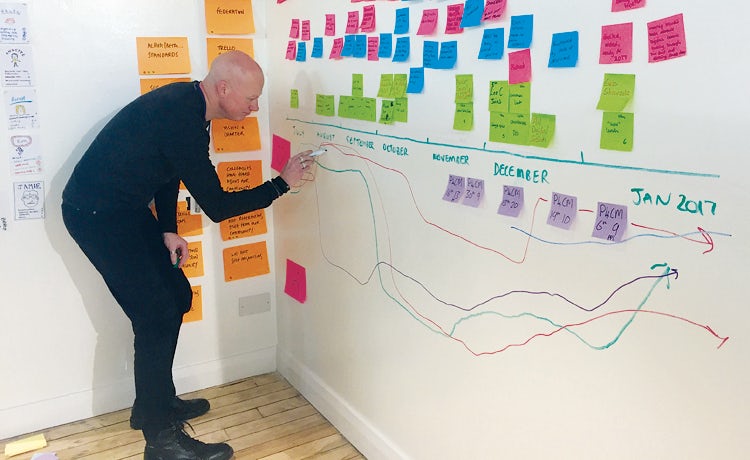Digital methodologies such as ‘agile’ are making the leap to other business functions, which means the writing is on the wall for marketers – on brightly coloured Post-It notes.

Last year was notable for a sense of realism. In 2016, Coca-Cola closed its startup incubator, Unilever moved to zero-based budgeting and McDonald’s signed a zero margin deal with Omnicom.
A year of broader tumult may have caused marketers to refocus, bringing a semi-backlash against many bright, young marketing technologies.
Commentators such as Econsultancy CEO Ashley Friedlein, advocating rationalisation in 2017, have variously rubbished, decried, or (in Friedlein’s case) gently played down the importance of virtual reality, beacons, wearables and the internet of things.
But there are a bunch of words that are namechecked more and more in digital and marketing. They include customer experience, customer-centred design and agile methodology.
These somewhat interconnected terms encompass a wide range of ideas. Their current popularity points to marketers adopting methodology from the world of IT and design to simplify an increasingly complex marketing ecosystem – and to benefit the customer.
But what do all these progressive terms really mean?
Customer-centred design
Co-op Digital has recently published its design manual, containing information on design principles, writing, patterns, accessibility, front-end prototyping and more.
The manual, as Co-op user experience manager Matt Tyas puts it, “signifies a move away from ‘rules’ about design elements, to evidence-based advice on how design patterns are used in combination to create compelling digital services. This advice will evolve as we learn more about what works for the people who use our services”.
Those seeking to understand customer-centred design would do well to read Co-op Digital’s design principles: to design in context, with purpose, for everyone, with honesty, in the open and iteratively.
Each principle comes with three or four points on how they should be demonstrated. They include:
- Understanding user needs, the market, technology and our business goals
- Looking at the whole experience for the user, not just the digital part
- Measuring and challenging the effectiveness of what we build
- Getting out of the way – helping users achieve their goals as quickly as they can
- Communicating in a clear, simple way; opening up our services to everyone
- Being truthful about what we can and cannot do for our users
- Not being afraid to experiment
- Releasing products earlier, learning faster
- Making design decisions based on evidence
- Responding to change
How is customer-centred design achieved?
Principles are great, but how do you ensure they are upheld? Here are some characteristics of design-led businesses:
- Design has a sponsor. For some startups such as Airbnb, the founders themselves have a design background. Elsewhere, the design director or possibly the chief digital officer bangs the drum to senior stakeholders.
- Designers are process leaders, shaping business strategy and not merely to be used as a service.
- Design and its implementation are rationalised, much as Co-op Digital is doing with its design manual.
- User advocacy is instilled. In the most famous design-led businesses this is institutionalised – think of Apple – but may otherwise require a team member on each project to represent the customer, a strategy employed at Airbnb.
- Internal collaboration through a cross-functional team ensures different skill sets can be brought to bear on finding the simplest and best solutions, with each department able to observe and reflect.
- External collaboration lets the customer join in the feedback process, though, as Co-op Digital points out, the organisation should learn “from what people do, not what they say they do”.
When it comes to quick release and iteration, marketing ops teams and agile methodology are increasingly being adopted.
In comparison to traditional ‘waterfall’ methodology, which starts with the gathering of requirements and then proceeds through the finalisation and sign-off of each stage of work, agile allows for projects to change as requirements and market conditions do. Collaboration, testing and iteration avoid extensive documentation and the clunky handover of projects between siloed teams. Often, processes and goals are simply recorded on Post-It notes arranged on a wall.
Marketing teams may not all be adopting agile completely faithfully, as digital teams might, but even with looser versions of project ‘sprints’– failing fast and tackling prioritised needs – progress can quickly be made.
The marketing ops team is not dissimilar in its ethos to agile methodology. The team sits across different marketing teams, such as growth, brand, customer and content, and has oversight of performance measurement, strategic planning, resource allocation and process development. Marketing ops gets things done using the test and learn approach with accountability through data.
UX aligns with business strategy
“There’s no longer any real distinction between business strategy and the design of the user experience.” So said Bridget van Kralingen, senior vice-president of IBM Global Business Services, in 2013.
This is a neat addendum to the design debate. Where the trend for customer-centred design is well-established in digital teams, expect marketing to follow suit as software improves and these respective departments further enmesh.
source”indiatoday”




